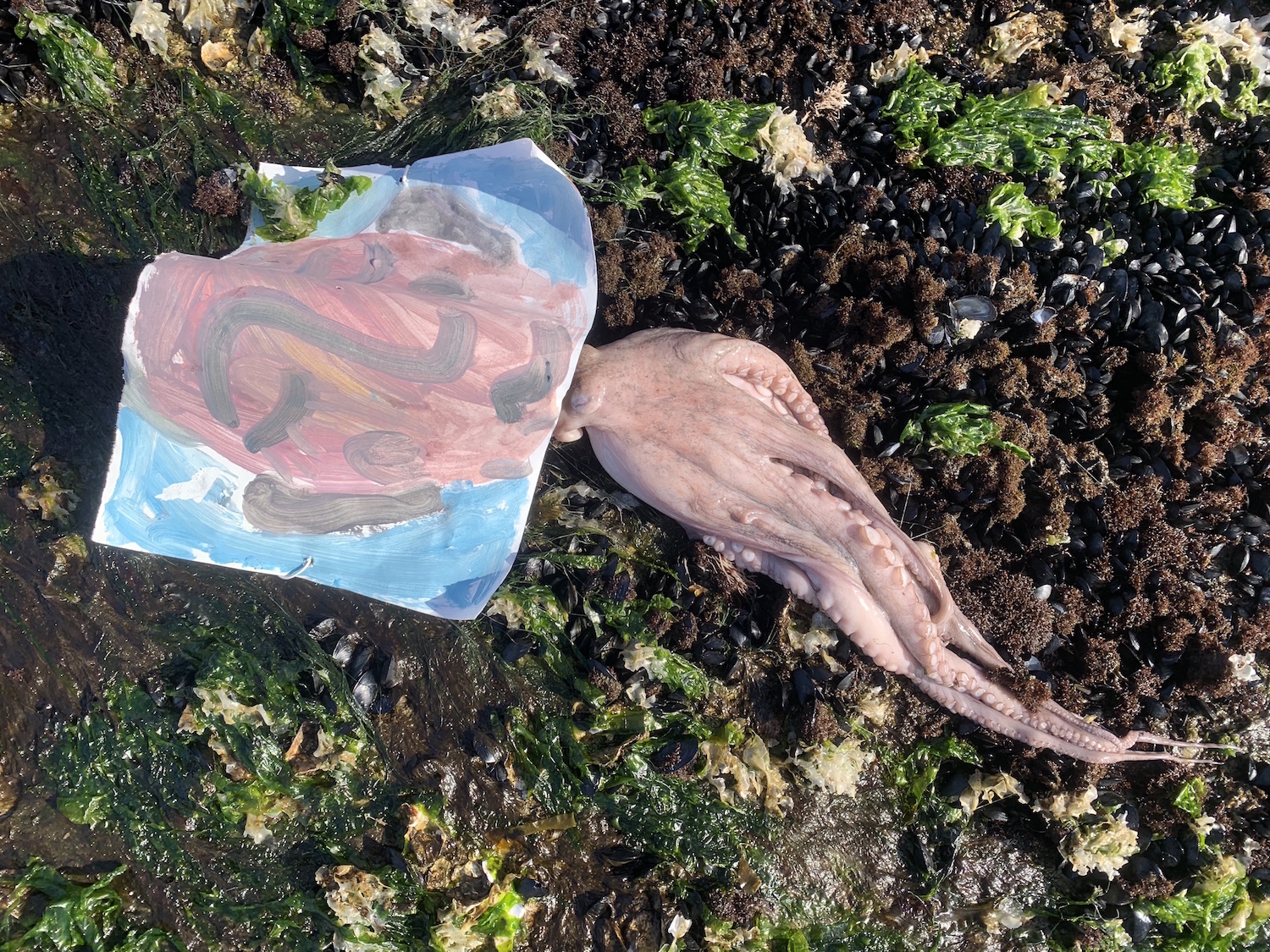Laure Prouvost: Melting into one another ho hot chaud it heating dip

A few days ago, while I was disinfecting my sneakers after coming home, I noticed the sides of the soles were spattered with black paint. I couldn't recall having passed by any construction site nor stepped on any dirty or wet pavement; in fact, the paint was already dry and impregnated into the rubber. However, it still exuded a slightly sickly, dense, and concentrated, if familiar, smell. That was when I re-entered—through memory—Laure Prouvost's exhibition at the Kunsthalle Lissabon, curated by João Mourão and Luís Silva.
It is the first time that Prouvost shows in Portugal (at lastl!), and I have no doubt this is one of the best exhibitions we have recently seen in Lisbon.
It is moderate in quantity—a main installation which gives name to the exhibition in addition to another smaller piece—but sufficiently inventive to comprise a complex network of materialities: one where the world is already, constantly another and where what we feel and think is immediately bargained with new sensations, feelings, uncertainties, and ideas.
Everything is experienced within fluxes. It is just like our entire sensorial system and the knowledge of things altered at the speed of circulating objects, information, and images; and the data of reality changed at the pace of synapses, dreams, and desire together with the contamination of smells, textures, liquid, and solid states or physical and immaterial elements. Prouvost links this process of free association to techniques of excavation and to subterranean areas.
"Keep digging, keep digging deeper and deeper…" the poem in the exhibition brochure reminds us.
The Kunsthalle venue, which is curiously enough a basement, has been transformed into a dark, damp space of nauseating smell. The floor is covered in a wet black substance that reeks of mollusc ink. Visibility is poor. Touch is more useful to walking than sight, which gradually, barely grows accustomed to the absence of light. We walk through corridors of thin curtains hanging side by side from the ceiling. It is impossible not to touch them with our bodies. Like gills of aquatic organisms, water runs off their surfaces. Sculptures that our touch recognises as tentacles are stuck fast to some of the curtains, which thus block the path; others let us through to a more spacious area, illuminated by the brightness of several separate digital video-images projected onto the soaked floor.
Now that we watch footage of a fruit-adorned octopus dragging piled-up images on the floor towards itself, and we notice a number of everyday objects and dross around us, we wonder: are we actually inside the head of an octopus specimen, witnessing its memories and dreams, its desires and intelligence, as its head contains its brain, stomach, and branchia?

However, no binarism survives in the interior spaces Prouvost digs. Apart from a video depiction of the octopus with female arms and from the pre-verbal half-human, half-animal moans we hear at the back, a number of glass-moulded tentacles grasping clay-cast female breasts and legs can be found all over the floor. A multitude of resonances thus connect the two worlds. Not only the human subconscious and libido but also digital culture, which absorbs all, recognise themselves in the animal's desire, voracity, and wet body. At this moment, the strong smell of mollusc ink queries us again. We know octopuses and other cephalopod molluscs release this glossy, slimy, black organic liquid as a means of protection, but Prouvost's surrealising language rejects naturalist approaches. This matter remains latent, with no concrete form, even though the action of extractivist politics on the ecosystem will not take long to come to mind—especially when, upon considering the economic and industrial capture of marine life, our attention is drawn to TV news of uncontrolled bushfires and floods amidst the projected images absorbed by the octopus.
On our way out, another piece titled The smoking mother is hot, 2023, attracts us. Tending to function as a line of flight, introducing as such a counterpoint into the exhibition, it is comprised of a mobile phone on the floor playing a video, the date of which fictionally fast-forwards us to three years from now. We stoop down to get a better view of it. A close-up footage of a hand pointing to a piece of ground covered with vegetation complements a whispering female voice-over. The latter asks us to get closer as it humourously seduces us and attempts to offer us something. Could it be an exit to life, to its germinal possibilities? As we look at the piece of ground on the screen and our desire to dig it increases, an idea of world too emerges and permeates the exhibition. This is a world in which all material elements—animal, vegetal, mineral, digital, objectual, human—take part, contaminating and confronting each other towards resingularisation. A clementine and some tree branches are found by the phone. The fresh atmosphere produced by the citric scent surrounds us, and we cannot help but touch the fruit—without the slightest awareness that in very few days all tactile experience would change, and that the multisensorial, ecological strategy of bodies employed by Prouvost would become ever more precious.
Sofia Nunes. Art critic and Ph.D candidate in Art History/Theory of Art at NOVA FCSH — UNL and Université Paris 1 Panthéon-Sorbonne. Curatorial assistant and exhibition producer at Museu do Chiado — MNAC, Ellipse Foundation, and the CCB Exhibition Centre from 2000 to 2007. Guest lecturer for the MA in Contemporary Art at Universidade Católica Portuguesa from 2009 to 2011. Regular writer to contemporary art and academic publications.
Translation PT-EN: Diogo Montenegro
Laure Prouvost: Melting into one another ho hot chaud it heating dip. Vistas gerais da exposição. Kunsthalle Lissabon. Fotos: Bruno Lopes. Cortesia da artista e Kunsthalle Lissabon.









